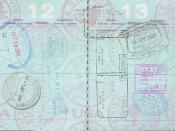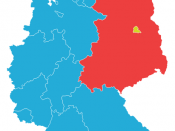Following the defeat of Germany in World War II, the heads of government of three of the victorious nations: the Soviet Union, Britain and the United States, held a conference to decide how to administer the defeated Nazi Germany. This was done through the Potsdam Conference, which took place in July of 1945: 9 weeks after Germany's unconditional surrender. Germany was then divided into 4 occupational zones between France, Britain, the United States and the Soviet; Berlin, which stood on Soviet grounds, was also divided into four sectors with the Western zone later becoming West Berlin and the Soviet's zone becoming East Berlin; East Germany's capital. Together these countries formed The Allied Control Council.
"A key term in the occupier's agenda was denazification: an allied initiative to rid German and Austrian society, culture, press, economy, judiciary and politics of any remnants of the Nazi regime," ("Germany", Wikipedia).
They were successful in this as all symbols of the Nazi regime were banned and even a new Germany flag was created.
Another term agreed to at Potsdam was the idea of decentralization. Despite the divisions, "Germany was to be treated as a unified unit with some central administrative departments," ("Germany", Wikipedia). However these plans collapsed in 1948, with the beginning of the Cold War, which in turn solidified the boundaries between the Soviet zone in the East and the United States, French and Britain's zone is the West. At that point the West was worried about their economical situation, but the American Marshall Plan aid was extended to Western Germany and a currency reform introducing the Deutsche Mark ended the concern by putting a stop to the inflation. The Soviets, however, did not agree to the currency reform and later withdrew from the four-power governing bodies. Their dissatisfaction with the idea was...


